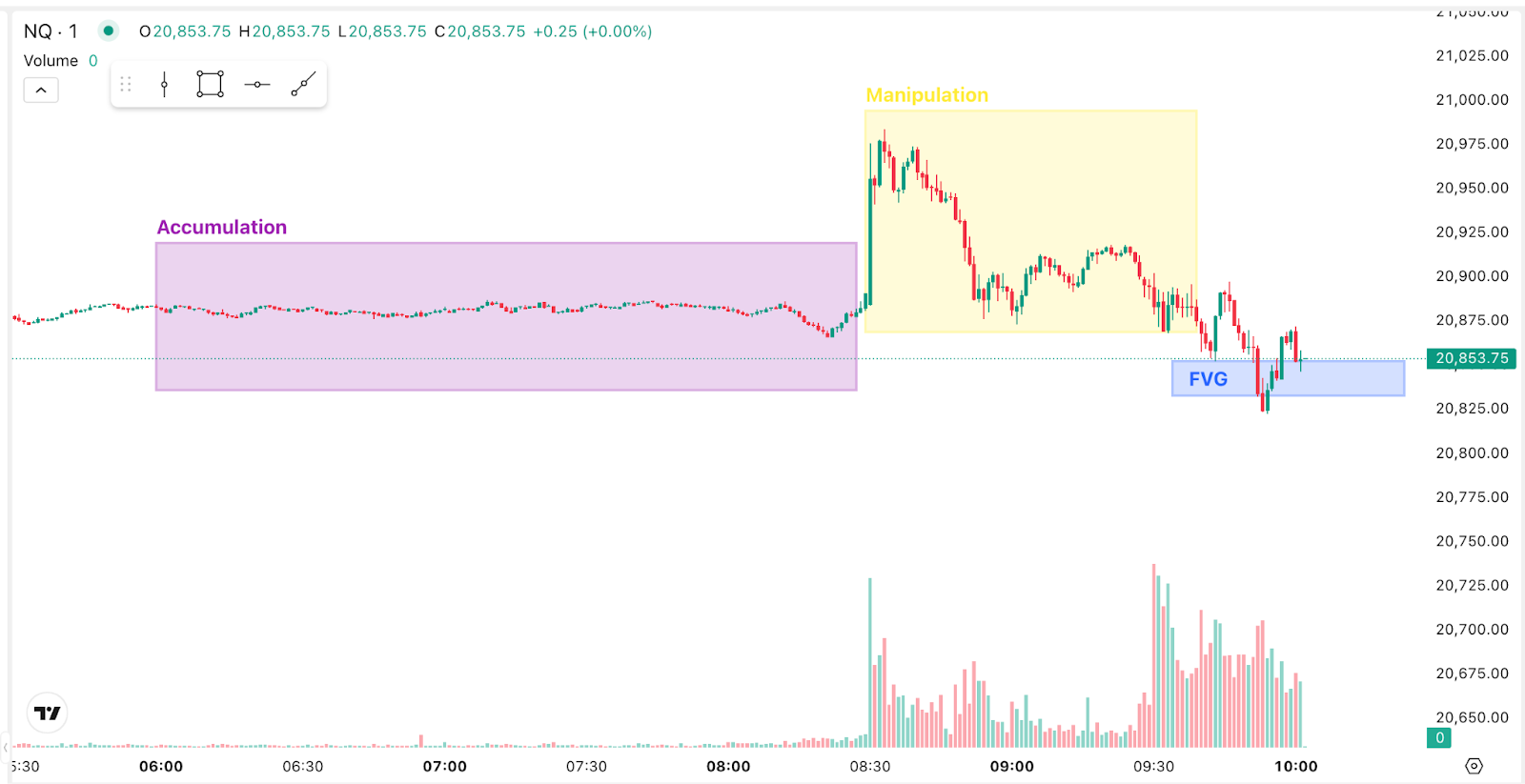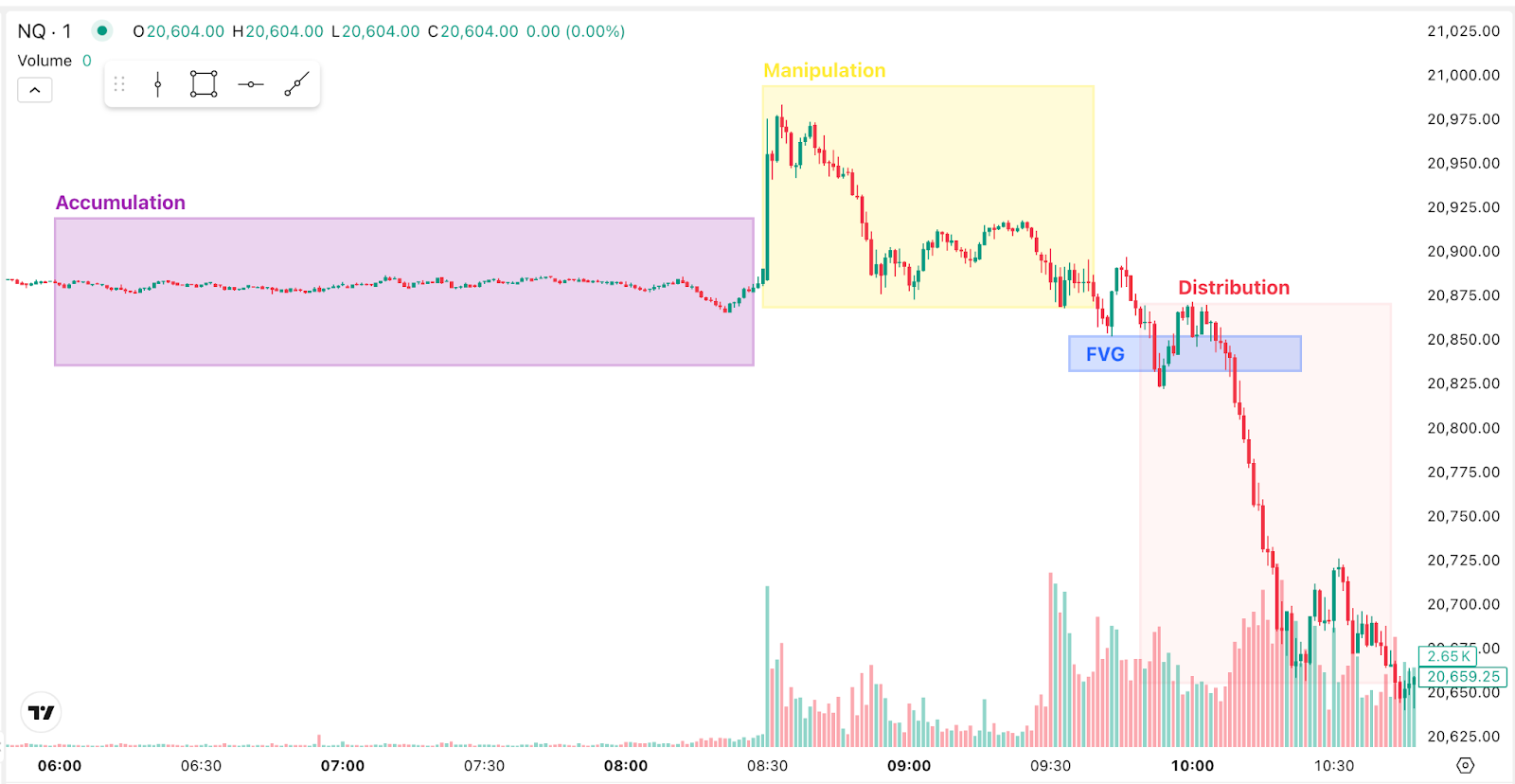Built For
Instruments: Futures
Trading Style: Day Trading
Playbook Overview
This playbook is built around the idea that markets move through three repeating phases: Accumulation, Manipulation, and Distribution (AMD). The focus is to observe how price builds liquidity (Accumulation), how it sweeps stops to trap traders (Manipulation), and then to enter trades only when the real move confirms itself in the Distribution phase, not during the Manipulation sweep itself.
The main goal is to protect trading capital and mental energy by avoiding low-quality, range-bound conditions and participating only when the market provides clear, high-probability directional moves during the Distribution phase. By recognizing these phases and aligning trades with clean market structure, this approach helps traders stay on the right side of liquidity, focus on strong risk-to-reward setups, and maintain discipline across different market environments.
This approach filters out chop and indecision by using major news events and a clear structure to decide when to stand aside and when to engage.
The best setups appear when price sweeps liquidity just before a big move, often around releases like CPI, FOMC, or NFP, and then confirms direction with clear displacement on a higher timeframe and a valid retracement on the lower timeframe. If no clean structure or catalyst is present, the safest trade is no trade.
Core concept
Accumulation: Price moves sideways, builds liquidity, and traps traders in chop. This phase is difficult to trade and often leads to stop-outs.
Manipulation: A sharp move that sweeps liquidity above or below a range. This move traps traders on the wrong side of the market and sets up the real directional leg. Manipulation is harder to trade directly — the focus is to wait for confirmation that it has happened.
Distribution: The cleanest phase to trade. After Manipulation sweeps liquidity, price breaks with intent and trends toward a clear target, such as equal highs or lows or a higher timeframe imbalance. This phase offers strong follow-through and higher reward-to-risk setups.
.jpg)
Displacement:
A valid setup requires clear displacement — a strong break of a swing high or low that leaves a fair value gap behind. If price respects that gap on a retrace, the move is valid.
Timeframe Alignment:
Use higher timeframes (1H, 4H, Daily) to spot the big picture: the draw on liquidity, key levels, and major FVGs.
Use lower timeframes (1m, 5m, 15m) to confirm displacement, find fair value gaps, and refine entries. If the higher timeframe is unclear, do not force a setup on a lower timeframe.
High vs. Low Probability Days
Low Probability Days:
- No major high-impact news.
- Bank holidays or the day after a holiday.
- The day before big news like CPI, FOMC, or NFP.
- The day after a large move that already tapped a major target.
- Price has jagged highs and lows with no clear direction.
High Probability Days:
- Major scheduled news: CPI, NFP, GDP, FOMC, PPI.
- Strong sweep of liquidity clearing obvious stops.
- Clean displacement and fair value gaps are visible on higher timeframes.
- High-probability setups usually appear during the New York session after the news, not during the spike.
Playbook Rules
Check the Economic Calendar
Look for high-impact news that could drive clean moves.
Check Market Correlation
Make sure related markets (e.g., NASDAQ and S&P) are aligned. If they diverge heavily, conditions are lower in probability.
Identify the Draw on Liquidity
There must be a clear target: equal highs/lows, an unfilled fair value gap, or a clean swing point. If there’s no obvious destination, do not trade.
Look for Displacement
Wait for price to break a key high or low with force, leaving a fair value gap behind. This shows the market has intent.
Entry and Risk Rules
- Enter on the retrace into the valid fair value gap.
- Take partial profits at logical targets (swing levels or next FVG).
- Trail stops to protect profits when the price confirms the move.
- If there’s no retracement, skip the trade — never chase.
Execution Rules
- Limit yourself to two trades per session. If you take two losses, step away for the day.
- Size down on days before major news or during known accumulation phases.
- Respect the “macro windows” — strong moves often happen around 9:50–10:10 and 10:50–11:10 Eastern Time.
- If conditions show no clear bias or structure, stand aside.
- Focus on discipline: sometimes sitting out protects more profit than forcing a trade.
Pros and Cons of the Strategy
This playbook is designed to deliver high-quality, repeatable setups — but like any trading strategy, there are key things to understand before using it.
Note: The cons listed here aren’t disadvantages. They are things to be aware of — important characteristics that require patience, discipline, and proper management to make the model work effectively.
Pros
- Provides a simple daily filter to separate good and bad days.
- Helps avoid chop and wasted trades in low-quality conditions.
- Makes it easier to wait for clean, strong moves with clear targets.
- Builds discipline and patience — no more forcing trades every day.
- Gives more confidence to hold for bigger wins when the structure is right.
Cons (Things to Be Aware Of and Manage)
- Some big moves won’t pull back — easy to miss trades.
- Waiting through slow days can test patience.
- Missed setups can cause FOMO if not managed.
- Setups can still fail — stops and risk rules matter.
- Discipline is non-negotiable; the plan only works if followed.
Trade Breakdown
Example Trade: CPI Short
Context
- CPI news released at 8:30 AM ET
- Futures: Nasdaq (NQ)
Accumulation
Price ranged sideways before the news, building liquidity above and below the pre-market range.
Manipulation
At the news release, the price spiked up sharply, sweeping stops above the range and trapping breakout buyers.
Distribution
After the spike, the price broke below a key pre-market swing low with strong momentum, leaving a bearish fair value gap. This confirmed that the real move was lower.

Execution
- Entered short on the retracement into the fair value gap.
- Stop loss placed above the high of the manipulation spike.
- Target: pre-market lows and equal lows under the range.
- The partial profit taken.
- Stop moved to protect gains as the price continued lower.
Result
A clean short trade in the Distribution phase: clear range, Manipulation sweep, confirmed break, and precise retrace entry. The move delivered around 100 points on Nasdaq futures within minutes











